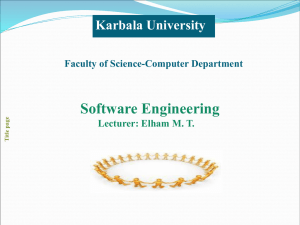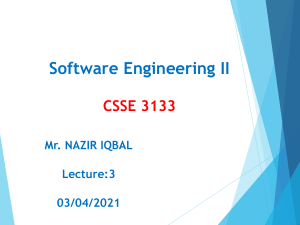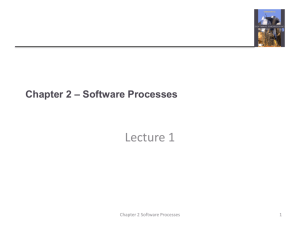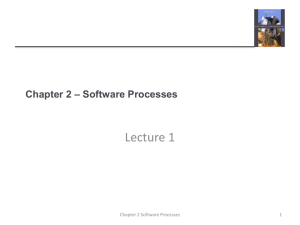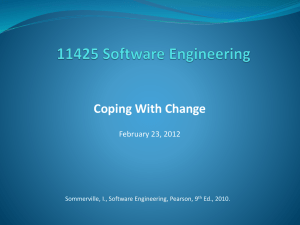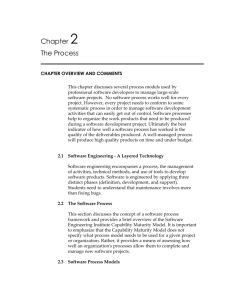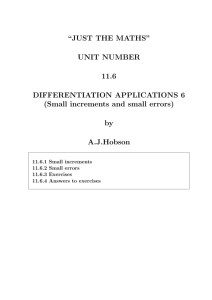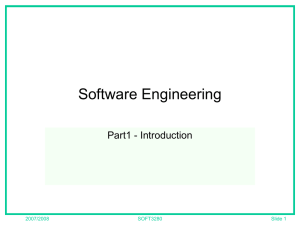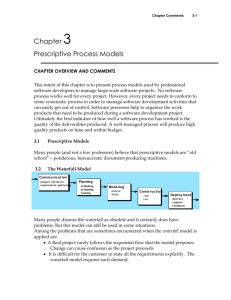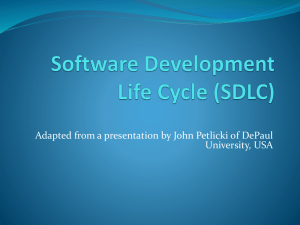Software Process
advertisement
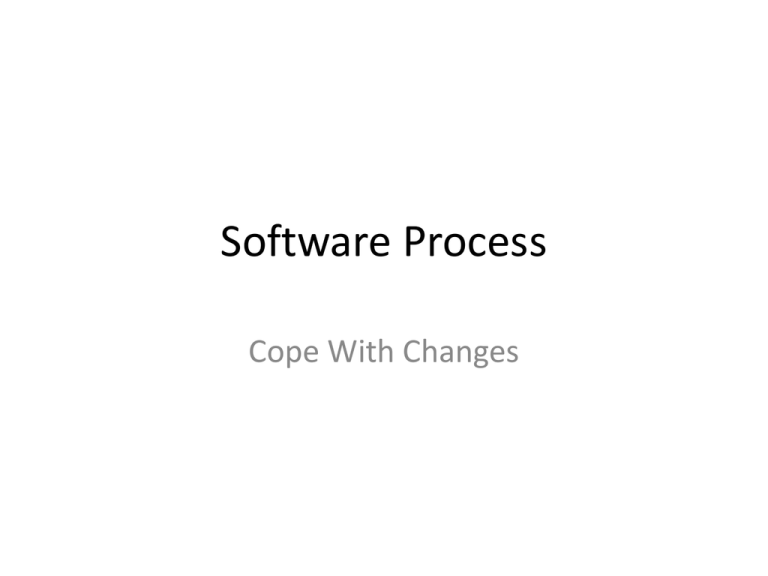
Software Process Cope With Changes Coping with change • Change is inevitable in all large software projects. – Business changes lead to new and changed system requirements – New technologies open up new possibilities for improving implementations – Changing platforms require application changes • Change leads to rework so the costs of change include both rework (e.g. re-analysing requirements) as well as the costs of implementing new functionality Chapter 2 Software Processes 2 Reducing the costs of rework • Change avoidance, where the software process includes activities that can anticipate possible changes before significant rework is required. – For example, a prototype system may be developed to show some key features of the system to customers. • Change tolerance, where the process is designed so that changes can be accommodated at relatively low cost. – This normally involves some form of incremental development. Proposed changes may be implemented in increments that have not yet been developed. If this is impossible, then only a single increment (a small part of the system) may have be altered to incorporate the change. Chapter 2 Software Processes 3 Software prototyping • A prototype is an initial version of a system used to demonstrate concepts and try out design options. • A prototype can be used in: – The requirements engineering process to help with requirements elicitation and validation; – In design processes to explore options and develop a UI design; – In the testing process to run back-to-back tests. Chapter 2 Software Processes 4 Benefits of prototyping • • • • • Improved system usability. A closer match to users’ real needs. Improved design quality. Improved maintainability. Reduced development effort. Chapter 2 Software Processes 5 The process of prototype development Chapter 2 Software Processes 6 Prototype development • May be based on rapid prototyping languages or tools • May involve leaving out functionality – Prototype should focus on areas of the product that are not well-understood; – Error checking and recovery may not be included in the prototype; – Focus on functional rather than non-functional requirements such as reliability and security Chapter 2 Software Processes 7 Throw-away prototypes • Prototypes should be discarded after development as they are not a good basis for a production system: – It may be impossible to tune the system to meet non-functional requirements; – Prototypes are normally undocumented; – The prototype structure is usually degraded through rapid change; – The prototype probably will not meet normal organisational quality standards. Chapter 2 Software Processes 8 Incremental delivery • Rather than deliver the system as a single delivery, the development and delivery is broken down into increments with each increment delivering part of the required functionality. • User requirements are prioritised and the highest priority requirements are included in early increments. • Once the development of an increment is started, the requirements are frozen though requirements for later increments can continue to evolve. Chapter 2 Software Processes 9 Incremental development and delivery • Incremental development – Develop the system in increments and evaluate each increment before proceeding to the development of the next increment; – Normal approach used in agile methods; – Evaluation done by user/customer proxy. • Incremental delivery – Deploy an increment for use by end-users; – More realistic evaluation about practical use of software; – Difficult to implement for replacement systems as increments have less functionality than the system being replaced. Chapter 2 Software Processes 10 Incremental delivery Chapter 2 Software Processes 11 Incremental delivery advantages • Customer value can be delivered with each increment so system functionality is available earlier. • Early increments act as a prototype to help elicit requirements for later increments. • Lower risk of overall project failure. • The highest priority system services tend to receive the most testing. Chapter 2 Software Processes 12 Incremental delivery problems • Most systems require a set of basic facilities that are used by different parts of the system. – As requirements are not defined in detail until an increment is to be implemented, it can be hard to identify common facilities that are needed by all increments. • The essence of iterative processes is that the specification is developed in conjunction with the software. – However, this conflicts with the procurement model of many organizations, where the complete system specification is part of the system development contract. Chapter 2 Software Processes 13 Boehm’s spiral model • Process is represented as a spiral rather than as a sequence of activities with backtracking. • Each loop in the spiral represents a phase in the process. • No fixed phases such as specification or design - loops in the spiral are chosen depending on what is required. • Risks are explicitly assessed and resolved throughout the process. Chapter 2 Software Processes 14 Boehm’s spiral model of the software process Chapter 2 Software Processes 15 Spiral model sectors • Objective setting – Specific objectives for the phase are identified. • Risk assessment and reduction – Risks are assessed and activities put in place to reduce the key risks. • Development and validation – A development model for the system is chosen which can be any of the generic models. • Planning – The project is reviewed and the next phase of the spiral is planned. Chapter 2 Software Processes 16 Spiral model usage • Spiral model has been very influential in helping people think about iteration in software processes and introducing the riskdriven approach to development. • In practice, however, the model is rarely used as published for practical software development. Chapter 2 Software Processes 17 The Rational Unified Process • A modern generic process derived from the work on the UML and associated process. • Brings together aspects of the 3 generic process models discussed previously. • Normally described from 3 perspectives – A dynamic perspective that shows phases over time; – A static perspective that shows process activities; – A practive perspective that suggests good practice. Chapter 2 Software Processes 18 Phases in the Rational Unified Process Chapter 2 Software Processes 19 RUP phases • Inception – Establish the business case for the system. • Elaboration – Develop an understanding of the problem domain and the system architecture. • Construction – System design, programming and testing. • Transition – Deploy the system in its operating environment. Chapter 2 Software Processes 20 RUP iteration • In-phase iteration – Each phase is iterative with results developed incrementally. • Cross-phase iteration – As shown by the loop in the RUP model, the whole set of phases may be enacted incrementally. Chapter 2 Software Processes 21 Static workflows in the Rational Unified Process Workflow Description Business modelling The business processes are modelled using business use cases. Requirements Actors who interact with the system are identified and use cases are developed to model the system requirements. Analysis and design A design model is created and documented using architectural models, component models, object models and sequence models. Implementation The components in the system are implemented and structured into implementation sub-systems. Automatic code generation from design models helps accelerate this process. Chapter 2 Software Processes 22 Static workflows in the Rational Unified Process Workflow Description Testing Testing is an iterative process that is carried out in conjunction with implementation. System testing follows the completion of the implementation. Deployment A product release is created, distributed to users and installed in their workplace. Configuration and This supporting workflow managed changes to the system (see change management Chapter 25). Project management This supporting workflow manages the system development (see Chapters 22 and 23). Environment This workflow is concerned with making appropriate software tools available to the software development team. Chapter 2 Software Processes 23 RUP good practice • Develop software iteratively – Plan increments based on customer priorities and deliver highest priority increments first. • Manage requirements – Explicitly document customer requirements and keep track of changes to these requirements. • Use component-based architectures – Organize the system architecture as a set of reusable components. Chapter 2 Software Processes 24 RUP good practice • Visually model software – Use graphical UML models to present static and dynamic views of the software. • Verify software quality – Ensure that the software meet’s organizational quality standards. • Control changes to software – Manage software changes using a change management system and configuration management tools. Chapter 2 Software Processes 25 Key points • Processes should include activities to cope with change. This may involve a prototyping phase that helps avoid poor decisions on requirements and design. • Processes may be structured for iterative development and delivery so that changes may be made without disrupting the system as a whole. • The Rational Unified Process is a modern generic process model that is organized into phases (inception, elaboration, construction and transition) but separates activities (requirements, analysis and design, etc.) from these phases. Chapter 2 Software Processes 26
